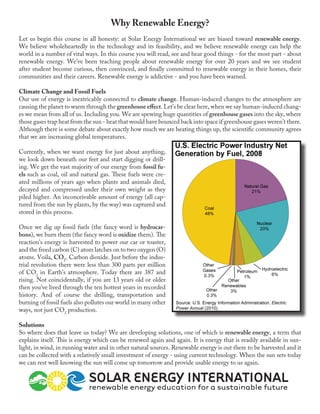
Renewables 1
- 1. Why Renewable Energy? Let us begin this course in all honesty: at Solar Energy International we are biased toward renewable energy. We believe wholeheartedly in the technology and its feasibility, and we believe renewable energy can help the world in a number of vital ways. In this course you will read, see and hear good things - for the most part - about renewable energy. We’ve been teaching people about renewable energy for over 20 years and we see student after student become curious, then convinced, and finally committed to renewable energy in their homes, their communities and their careers. Renewable energy is addictive - and you have been warned. Climate Change and Fossil Fuels Our use of energy is inextricably connected to climate change. Human-induced changes to the atmosphere are causing the planet to warm through the greenhouse effect. Let’s be clear here, when we say human-induced chang- es we mean from all of us. Including you. We are spewing huge quantities of greenhouse gases into the sky, where those gases trap heat from the sun - heat that would have bounced back into space if greenhouse gases weren’t there. Although there is some debate about exactly how much we are heating things up, the scientific community agrees that we are increasing global temperatures. Currently, when we want energy for just about anything, we look down beneath our feet and start digging or drill- ing. We get the vast majority of our energy from fossil fu- els such as coal, oil and natural gas. These fuels were cre- ated millions of years ago when plants and animals died, decayed and compressed under their own weight as they piled higher. An inconceivable amount of energy (all cap- tured from the sun by plants, by the way) was captured and stored in this process. Once we dig up fossil fuels (the fancy word is hydrocar- bons), we burn them (the fancy word is oxidize them). The reaction’s energy is harvested to power our car or toaster, and the freed carbon (C) atom latches on to two oxygen (O) atoms. Voila, CO2 . Carbon dioxide. Just before the indus- trial revolution there were less than 300 parts per million of CO2 in Earth’s atmosphere. Today there are 387 and rising. Not coincidentally, if you are 13 years old or older then you’ve lived through the ten hottest years in recorded history. And of course the drilling, transportation and burning of fossil fuels also pollutes our world in many other ways, not just CO2 production. Solutions So where does that leave us today? We are developing solutions, one of which is renewable energy, a term that explains itself. This is energy which can be renewed again and again. It is energy that is readily available in sun- light, in wind, in running water and in other natural sources. Renewable energy is out there to be harvested and it can be collected with a relatively small investment of energy - using current technology. When the sun sets today we can rest well knowing the sun will come up tomorrow and provide usable energy to us again.
- 2. More Reasons for Renewable Energy Pollution and climate change are powerful reasons to cut down our use of coal, oil and natural gas. But the environment is not the only reason to replace fossil fuel sources with renewables. In fact, if fossil fuels emitted no pollution whatsoever they would still be causing big problems for modern society. Non-Renewable = Finite We have worked very hard since the industrial revolution began to build extensive infrastructure for mining, drilling, transporting, refining, and distributing fossil fuels. We work equally hard on the demand side. For example, last year about 50 million cars were built to run on fossil fuels. Not to mention countless furnaces, hot water heaters, airplanes, and power plants. All the while, we know that the energy sources powering all of these will run out. Oil, for exam- ple, is approaching (or may even have passed) its peak production. That means the amount of oil extracted from the earth will dwindle as the years march on. As oil becomes rarer and more difficult to retrieve, it will become evermore expensive. Eventually, the expense of buying gasoline will be so high that gas-fueled cars will stay parked. And the money, materials and effort that went into those cars will be wasted. Renewable Energy = Domestic Energy Currently, we import much of our fossil fuel, especially oil, from other countries. In 2008, 57% of the oil used in America came from outside of U.S. borders. That figure represents oil flowing into the U.S. at a rate of 11 mil- lion barrels per day. That figure also represents $200,000 per minute leaving the U.S. economy - to support the economies of Canada, Saudi Arabia, Venezuela and Nigeria. In the world of diplomacy, energy means power. Today, those with abundant fossil fuels have power to make demands and the power to raise prices. Worldwide competition for dwindling supplies of oil can lead - and has already lead - to deadly and expensive wars. Many renewable energy advocates see these conflicts as unnecessary. With a fraction of our current investment in oil, we can begin to build the technology and infrastructure necessary to replace our fossil fuel infrastructure with renewable energy infrastructure. This transition would create a new energy-based economy requiring people to fill millions of new jobs. The source of energy for the new renewable energy infrastructure is the sun. To be fair, the sun’s energy will not last forever either. Scientists predict the sun will only be around for another 5 billion years or so.
